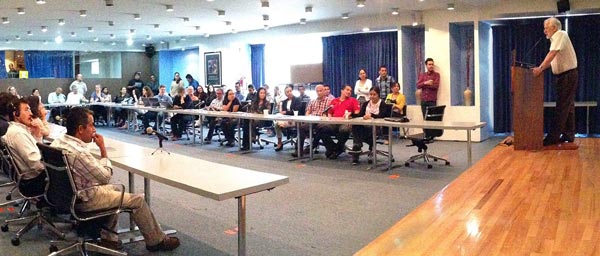
Dr. Thomas Lumpkin/CIMMYT Director General Mexico is seen by many as one of the strongest emerging economies, with a high GDP and strong purchasing power parity. Yet a commonly overlooked fact is that nearly 23 percent of Mexicans, some 27.4 million citizens, still suffer from food shortages and insecurity1. In late 2010, CIMMYT and the Mexican Secretariat of Agriculture, Livestock, Rural Development, Fisheries and Food (SAGARPA) launched the Sustainable Modernization of Traditional Agriculture project (MasAgro) to raise farm community living standards and foster sustainable food security through research, development, training and the transfer of technology —ultimately to make a difference to the lives of these millions.
From an initial budget of US$ 3 million to a budget of nearly US$ 20 million in 2014, MasAgro has been seen as a success and was described by the G20 Mexico Agriculture Group as “an experience that could serve as a model for coordinating research and development, innovation, transfer of technology, as well as public-private links in the agri-food sector.” Nonetheless, since the 2012 elections and change of government, as is typical, there has been a shift in priorities within SAGARPA with an increased focus on impact and downstream research. These changes also resulted in a changing vision for MasAgro, including new administrative rules. As a result, after months of extended negotiations, the technical annex between CIMMYT and the new SAGARPA administration was agreed upon by both parties, and signed last week.
For many across CIMMYT, the past few months have been a period of uncertainty, and I am grateful to all our staff for their patience during this difficult process. We are now entering a new phase of MasAgro with a broader vision and broader host of donors. MasAgro’s work, scientific research and innovation are integrated into CIMMYT’s strategy. MasAgro is an instrument to achieve a goal — to raise maize and wheat production in a sustainable manner in Mexico and perhaps other countries within Latin America — and this goal will remain beyond the parameters of a project’s lifespan.
CIMMYT’s mission — to increase the productivity of maize and wheat systems for global food security and reduce poverty — means that we must develop capacities across the entire value chain. Our challenge remains to accelerate the delivery of results but also to convince taxpayers, development agencies and policymakers that it is essential to invest in research. New crop varieties, good agronomic technologies and efficient value chains are the key drivers of growth in agricultural productivity.
Looking beyond the CIMMYT-SAGARPA relationship, CIMMYT is expanding MasAgro’s innovation and partnership model directly to Mexican state governments and to other Latin American countries.
For example, the Mexican state of Guanajuato has committed MX 10 million pesos (US$ 760,000) for 2014 to the Take It to the Farmer initiative, and there have been requests from the governments of Guatemala and Bolivia to replicate parts of the MasAgro model. Key innovations — ICT in agriculture, precision agriculture, post-harvest management, maize landrace improvement and conservation agriculture — are readily available for transfer to other countries. MasAgro and its many partners have achieved impressive results in just three short years (see box on page 2). Knowledge and insight gained from this pioneering project are serving as a blueprint for other CIMMYT projects and indeed other countries.
MasAgro’s Achievements and Impacts:
• 200,000 farmers are linked to MasAgro activities.
• 166 communities are engaged as part of the National Crusade Against Hunger.
• GreenSeekerTM technology has generated farmer savings in fertilizer application of US$ 1.7 million.
• 13 prototypes of agricultural machinery have been developed.
• 181 technicians have been certified in training on conservation agriculture.
• A network of more than 2,000 technicians is providing technical assistance to more than 60,000 farmers.
• Maize farmers applying MasAgro technologies have achieved an average yield increase of 25.4 percent. • More than 3,700 farmers are receiving agronomic and climate information via the MasAgro Móvil phone service.
• 40,000 ultra-high-density genetic profiles of wheat varieties and 20,000 of maize landraces have been generated.
• The largest search for heat and drought tolerance undertaken in any crop has been initiated, evaluating more than 70,000 wheat varieties for these traits.
• 4,000 landraces are being used to establish the relationship between genome-based information and traits such as drought tolerance and disease resistance. This is the most complete genome-wide association study (GWAS) in the history of maize research.
New Leadership for MasAgro
Dr. Bram Govaerts, Associate Director for the Global Conservation Agriculture Program, will assume the leadership of MasAgro, with responsibility for coordinating the evolution of related projects in Latin America. Bram joined CIMMYT in 2007 and since 2010 has been the leader for the MasAgro Take It to the Farmer initiative. Bram received his bachelor’s degree, master’s degree and Ph.D. from the Katholieke Universiteit Leuven in Belgium in bioscience engineering and agricultural production systems.
 Nutrition, health and food security
Nutrition, health and food security 
